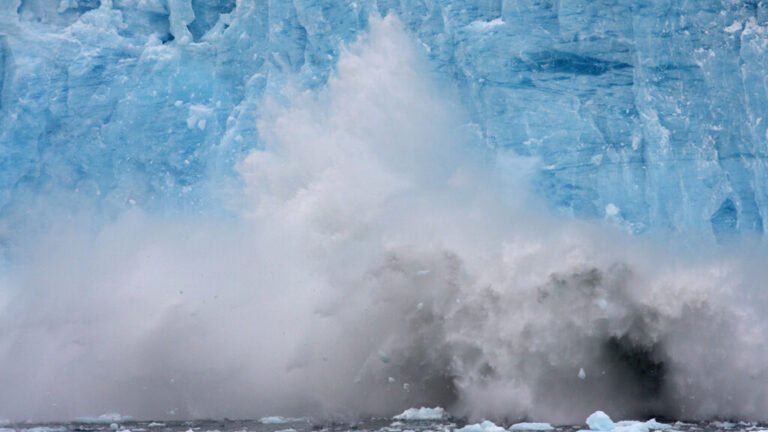

The world is warming, yet summer temperatures on the southern slope of Mount Everest, measured continuously by the Pyramid Laboratory since 1994, have dropped over the past 15 years.
The reason? Cold downslope winds, caused by the increased temperature differences between the warmer air above the glacier and the air mass in direct contact with the glacier’s frozen surface.
These katabatic winds create a cooling effect around mountain glaciers, explained Thomas Shaw, a glaciologist at the Institute of Science and Technology Austria. “They’re melting more slowly than they would if there was a one-to-one correspondence between atmospheric temperature and the temperature of the glacier boundary layer.”
Scientists have made note of this phenomenon since the late 1990s, but studies have so far been limited to specific glaciers.
To understand the phenomenon’s extent and the factors influencing it on a global scale, Shaw and his colleagues collected and analyzed a dataset from 62 glaciers across 169 glacier campaigns, amounting to an unprecedented 3.7 million hours of air temperature data.
While much of the data were easily accessible, some were “almost the equivalent of being written on the back of a napkin,” said Shaw, who was able to include previously unpublished data from other researchers. “It takes a lot of emailing, clicking, finding, searching, and thinking, ‘Oh, I remember there was someone that published something on this.’”
Changing Projections
The study, published in Nature Climate Change, found that the glacier boundary layer warms an average of 0.83°C for every degree of ambient warming.
“This is not the only process affecting glacier melt, but it’s an important one that we didn’t have proof of before,” said Inés Dussaillant, a glaciologist at Centro de Investigación en Ecosistemas de la Patagonia in Chile who was not involved in the study.
“It may change our projections…and IPCC reports for the future evolution of glaciers or sea level contribution.”
Currently, this effect is not taken into account when modeling how glaciers will change over time, said Harry Zekollari, a glaciologist at Vrije Universiteit Brussel in Belgium who was not involved with the study. “It may change our projections and how we make them, and it may change projections and [Intergovernmental Panel on Climate Change] reports for the future evolution of glaciers or sea level contribution.”
According to Shaw’s analysis, the main factors driving the cooling effect are the temperature difference between the glacier boundary layer and the surrounding air, the size of the glacier, and humidity. Debris cover on the glacier and strong synoptic winds hinder the effect.
This phenomenon means that rising ambient temperatures actually increase the cooling effect on large glaciers—but only up to a point. “Glaciers are not protected because of this; they’re not cooling. It’s a bit of a misnomer,” said Shaw. While they are melting more slowly than would be expected with linear warming, the effect is still substantial. The study projects that globally, these near-surface cooling effects will peak during the late 2030s as temperatures rise.
As glaciers shrink in size, they will no longer be able to generate katabatic winds, and their rate of warming will begin to reflect ambient temperatures. According to the study, this will lead to accelerated melting from mid-century onward.
Going, Going, Gone
Shaw and his coauthors noted large regional variations in the data. While the cooling effect is not expected to peak until the 2090s for glaciers in New Zealand and the southern Andes, glaciers in central Europe have likely already passed this mark and are deteriorating at an increasing pace.
The study’s results tally with other findings. Earlier this year, a study of global glacier mass changes found that central Europe lost 39% of its ice mass between 2000 and 2023, faring the worst of all 19 regions studied.
A prime example is Pasterze, an Austrian glacier where research into the cooling phenomenon first started in the 1990s. “This was once a much larger glacier, with a much stronger observed katabatic cooling effect. Now it’s disintegrating very fast,” said Shaw, noting it will likely not be Austria’s largest glacier for much longer. “It’s already showing evidence of how rapidly glaciers can react to climate when they begin to disappear.”
But while troves of reliable long-term data are available for areas like the European Alps, Iceland, Svalbard, and western North America, glacier monitoring is not equally distributed worldwide. Dussaillant would like to see more support for regions where governments are not able to maintain ongoing glacier monitoring. “We cannot really say that this is the global picture, when in fact, some regions still have huge gaps which we need to fill and better understand.”
With around 200,000 glaciers worldwide, there is, indeed, still a lot of work to be done before a truly global picture emerges, said Zekollari. “But it’s a massive step forward compared to what we had.”
—Kaja Šeruga, Science Writer
Citation: Šeruga, K. (2025), Glaciers are warming more slowly than expected, but not for long, Eos, 106, https://doi.org/10.1029/2025EO250430. Published on 20 November 2025.
Text © 2025. The authors. CC BY-NC-ND 3.0
Except where otherwise noted, images are subject to copyright. Any reuse without express permission from the copyright owner is prohibited.


